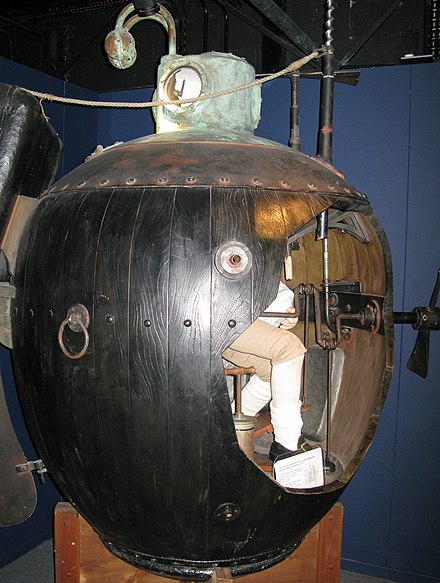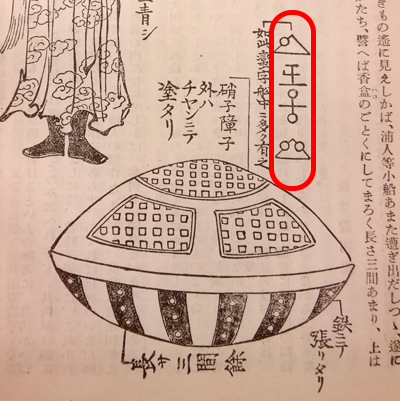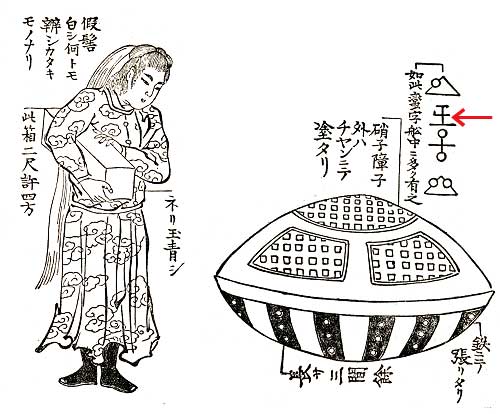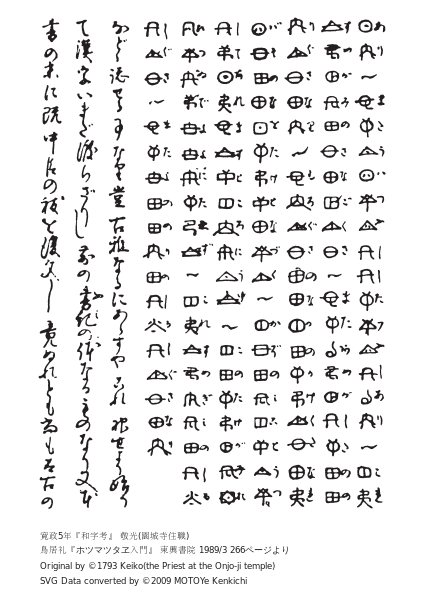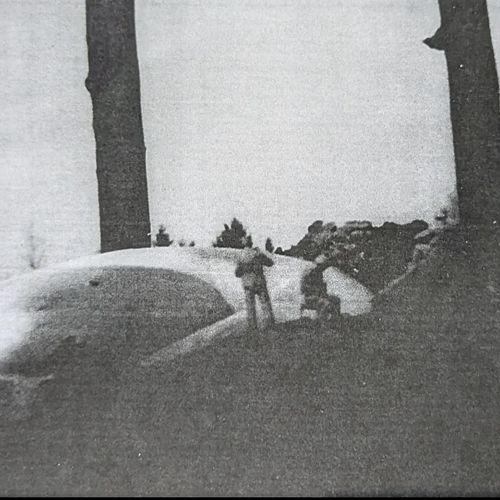| ID | #1522942300 |
| Добавлен | чт, 05/04/2018 |
| Автор | July N. |
| Источники | |
| Феномены | |
| Состояние | Расследование
|
Исходная информация
22 февраля 1803 года несколько японских рыбаков из провинции Хитати обнаружили дрейфующий у самого берега «корабль» очень странной формы.
Самый старый отчет об Утсуро Бунэ взят из книги, которая, как считается, была опубликована в 1815 году и называлась «Оушуку Дзакки» (鶯宿雑記; «Разные заметки из соловьиной таверны»). Текст на одном листе и иллюстрация дают краткое описание события и излагают основные факты.
Существует три подробных различных записанных рассказа об этой истории (1825, 1835 и 1844 годов), детали в которых незначительно различаются:
- Тоен Сосетсу (Tales from the Rabbit Garden, «Рассказы из садика кролика»), которую составил в 1825 году Киокутей Бакин.
- Хюруи Кису (The Story of Shipwreck, «Дневники и рассказы о побегах»), составленной в период Эдо в 1835 году неизвестным автором.
- И Уме-но-чири («Пыль абрикоса»), составленный в 1844 году Нагахаси Матаджиро.
Из любопытства они решили его обследовать, вытащили на берег и забрались на борт. Размеры загадочной посудины составляли примерно 330 см в высоту и 540 см в ширину и напоминало рыбакам рыбакам кохако (японская курильница).
Верхняя часть была сделана из материала, похожего на палисандровое дерево, покрытое красным лаком, а нижняя часть покрыта медными тарелочками, судя по всему для защиты от острых подводных камней. В верхней части судна было несколько окошек, сделанных из стекла или каких-то кристаллов, которые были покрыты чем-то похожим на древесную смолу. Между тем окна были достаточно прозрачными, чтобы рыбаки могли заглянуть внутрь.
Внутренняя часть Уцуро-бунэ* (虚舟, буквально полый корабль - так рыбаки называли загадочное судно) была украшена надписями на незнакомом языке. Потом рыбаки вошли в каюту и обнаружили там две простыни, бутылку с водой (около 3,6 литров), несколько кексов и мясной паштет. А потом рыбаки увидели и хозяйку судна – прекрасную девушку лет 18 или 20-ти. У девушки были рыжие волосы и брови, причем волосы ее были искусственно удлинены какими-то белыми нитями.
Одежда на ней была длинная, из очень красивого материала, которого рыбаки никогда раньше не видели. Девушка приветливо улыбалась и пыталась что-то сказать, но язык был незнакомым, так что ничего разузнать не удалось. Кроме того, девушка и все время прижимала к себе небольшой ящичек, к которому никому не давала прикоснуться.
В конце концов, рыбаки отправили незнакомку обратно в море и занялись своими делами.
* Есть предположение, что «утсуро бунэ» первоначально описывало выдолбленный ствол дерева, в который набивали жертву, а затем выпускали в море; хотя для этого очень мало доказательств, кроме имени.
_____________________________
Согласно их сообщениям, в феврале или марте 1803 года рыбаки на побережье провинции Хитачи стал свидетелем того, как странное судно подошло к берегу. Он был в форме курильницы (нижняя часть в форме перевернутого конуса и верхняя половина выпуклой), имел размеры более пяти метров в диаметре и более трех метров в высоту и был сделан из сандалового дерева и металлические, со стеклянными окнами.
Из него вышла молодая женщина с белой кожей и светлыми волосами, говоря на неизвестном языке.
Она держала коробку длиной около полуметра, которую не хотела выпускать из рук и никому не давала в нее заглянуть. Внутри корабля были найдены запасы еды и питья, циновки из неизвестного материала и надписи, которые никто не мог расшифровать.
Когда туземцы увидели, что не могут договориться с посетительницей, они посадили ее обратно в лодку и оттолкнули от берега.
Оригинальная новость
Il y a plus de 200 ans, un OVNI se serait échoué sur le rivage au Japon. De cet engin, un mystérieux extraterrestre ayant l’apparence d’une femme en serait sorti. Cette incroyable affaire fera bientôt l’objet d’une nouvelle enquête publiée dans un livre à paraître.
Les documents et les images disponibles, réalisés au moment des faits, correspondent parfaitement aux récits modernes concernant les OVNI. Cette affaire date de plus de deux siècles soit bien avant 1947, soit l’année où le monde a pris conscience du phénomène OVNI. Cette année-là, Kenneth Arnold, un pilote privé, a affirmé avoir vu neuf disques brillants voler à des vitesses supersoniques.
Le récit d'Arnold est considéré comme la première observation de ce que l'on appelait alors les « soucoupes volantes » dans les médias. Mais une œuvre d'art beaucoup plus ancienne au Japon représente un navire de forme similaire.
Ces documents indiquent les détails d'un incident survenu sur une plage japonaise en 1803.
Un vaisseau en forme de disque appelé Utsuro-bune se serait échoué sur la plage de Harato-no-hama dans la province de Hitachi. Il a été décrit comme ressemblant à une marmite à riz.
Il avait du verre sur le toit, et possédait des plaques de protection en métal.
Le plus étrange, c’est qu’à l’intérieur de l’engin, il y avait des inscriptions étranges et énigmatiques. En outre, la femme solitaire qui pilotait ce vaisseau parlait une langue inconnue.
Selon la légende, la femme avait la peau rose, les cheveux roux et porterait une boîte qu'elle refusait d'ouvrir.
Les pêcheurs troublés ont supposé qu'elle était une princesse étrangère et ont renvoyé son vaisseau à la mer.
Dans le folklore japonais, l'incident a longtemps été considéré comme faisant partie des légendes d'Utsuro-bune.
Ces légendes ont été transmises au Japon avec de légères variantes.
Mais la fièvre des OVNIS est née aux États-Unis en 1947 et de nouvelles conspirations entourent maintenant ce récit surprenant.
Un total de 12 documents détaillant le même incident ont été trouvés, qui selon les ufologistes est un indicateur de la validité de l'incident.
Mais était-ce vraiment une rencontre rapprochée du troisième type ?
Des scientifiques ne croient pas l’hypothèse d’un vaisseau. Ils ont noté qu’aucun des témoins n’avait vu l’engin volé ou qu’il était doté d’une technologie remarquable.
Shoichi Kamon a tenté de résoudre ce mystère dans son livre intitulé, « The Mystery of Utsuro-bune » (aux éditions Flying Disk Press), dans lequel il compare les points de vue scientifique, historique et folklorique de cette affaire.
__________________________
On February 22, 1803, local fishers of the Harayadori (はらやどり) shore in the Hitachi province saw an ominous "ship" drifting in the waters. Curious, they towed the vessel back to land, discovering that it was 3.30 metres (10.83 feet) high and 5.45 metres (17.88 feet) wide, reminding the witnesses of a Kōhako (Japanese incense burner). Its upper part appeared to be made of red coated rosewood, while the lower part was covered with brazen plates, obviously to protect it against the sharp-edged rocks. The upper part had several windows made of glass or crystal, covered with bars and clogged with some kind of tree resin. The shape of the hollow boat resembled a wooden rice pit. The windows were completely transparent and the baffled fishermen looked inside. The inner side of the Utsuro-bune was decorated with texts written in an unknown language. The fishermen found items inside such as two bed sheets, a bottle filled with 3.6 litres of water, some cake and kneaded meat. Then the fishermen saw a beautiful young woman, possibly 18 or 20 years old. Her body size was said to be 1.5 metres (4.92 feet). The woman had red hair and eyebrows, the hair elongated by artificial white extensions. The extensions could have been made of white fur or thin, white-powdered textile streaks. This hairstyle cannot be found in any literature. The skin of the lady was a very pale pink color. She wore precious, long and smooth clothes of unknown fabrics. The woman began speaking, but no one understood her. She did not seem to understand the fishermen either, so no one could ask her about her origin. Although the mysterious woman appeared friendly and courteous, she acted oddly, for she always clutched a quadratic box made of pale material and around 0.6 m (24 in) in size. The woman did not allow anyone to touch the box, no matter how kindly or pressingly the witnesses asked.
An old man from the village said in theory, "This woman could be a princess of a foreign realm, who married at her homeland. But when she had an affair with a townsman after marriage, it caused a scandal and the lover was killed for punishment. The princess was banned from home, for she enjoyed lots of sympathy, so she escaped the death penalty. Instead, she might have been exposed in that Utsuro-bune to leave her to destiny. If this should be correct, the quadratic box may contain the head of the woman's deceased lover. In the past, a very similar object with a woman was washed ashore on a close-by beach. During this incident, a small board with a pinned head was found. The content of the box could therefore be the same, which would certainly explain why she protects it so much. It would cost lots of money and time to investigate the woman and her boat. Since it seems to be tradition to expose those boats at sea, we should bring the woman back to the Utsuro-bune and let her drift away. The townspeople were frightened. In a different version, the lady from the hollow boat stays where she landed and grows to old age. From human sight it might be cruel, but it seems to be her predetermined destiny." The fishermen reassembled the Utsuro-bune, placed the woman in it, and set it to drift away into the ocean.
____________________________
Ucuro-bune (虚舟, doslova dutá loď) je příběh ze starých japonských kronik, vyprávějící o záhadné ženě, která se vynořila z moře.
Primárním zdrojem informací je kniha Příběhy z králičí zahrady, kterou vydal roku 1825 Kjókutei Bakin, a anonymní spis Příběh o ztroskotání z roku 1835. Podle jejich podání byli v únoru nebo březnu 1803 rybáři na pobřeží provincie Hitači svědky toho, jak k břehu připlulo podivné plavidlo. Mělo tvar nádoby na pálení vonných látek (spodní část ve tvaru obráceného kužele a horní polovina vypouklá), měřilo přes pět metrů v průměru a přes tři metry na výšku a bylo zhotoveno ze santalového dřeva a kovu, se skleněnými okýnky. Z něho vystoupila mladá žena s bílou pletí a světlými vlasy, která hovořila neznámým jazykem. Držela skříňku asi půl metru dlouhou, kterou nechtěla dát z ruky ani do ní nikoho nenechala nahlédnout. Uvnitř lodi byly nalezeny zásoby jídla a pití, rohože z neznámé látky a nápisy, které nikdo nedokázal rozluštit. Když domorodci viděli, že se s návštěvnicí nemohou nijak domluvit, posadili ji zpátky do lodi a odstrčili od břehu.
Vysvětlení události je nejasné. Mohlo jít o čistý výplod fantazie nebo o zkomolenou verzi staršího příběhu (historik Kunio Janakita zmiňuje, že motiv dívky, která přišla z moře, se objevuje v japonských legendách už od 8. století). Kjókutei Bakin uvádí domněnku, že žena v lodi byla princeznou z cizí země, která navázala milostný poměr s poddaným. Za trest byl mladík popraven a dívka vypovězena ze země. Ve schránce pak s sebou nosila právě hlavu mrtvého milence. Vzhledem k tomu, že Japonsko bylo v období Edo zcela izolováno od zbytku světa, případné setkání s cizinkou, patrně zachráněnou ze ztroskotané lodi (žena podle popisu patřila k europoidní rase, ačkoli na dobových ilustracích je vzhledem ke konvenci zobrazována jako Japonka) mohlo na venkovany silně zapůsobit a dát prostor k různým spekulacím a vymýšlení barvitých podrobností. Není ani vyloučeno, že se rybáři stali nedobrovolnými svědky zkoušky nového plavidla: první funkční ponorku spustil na vodu Robert Fulton roku 1800. Záhadologové poukazují na podobnost ucuro-bune s létajícím talířem a tvrdí, že osoba popisovaná v legendě byla návštěvnicí z jiné planety nebo že šlo o případ cestování časem. Existují také spekulace o USO (Unidentified submerged object, neidentifikovaný podmořský předmět), podle nichž létající talíře neřídí mimozemšťané, ale příslušníci dosud neobjevené podmořské civilizace. V této souvislosti se poukazuje na to, že oblast jihovýchodně od ostrova Honšú bývá nazývána Ďáblovo moře nebo Dračí moře a váže se k ní řada strašidelných pověstí, takže je v populární literatuře srovnávána s Bermudským trojúhelníkem.
Ucuro-bune je dosud populárním námětem sešitů manga, na místě údajného přistání byla jako turistická atrakce vybudována replika duté lodi.
_____________________________
Translated and Adapted from Toen Shōsetsu, Hyōryū kishū, Ume no Chiri, Japanese Wikipedia, and Other Sources
Legend or fact? In the early 1800s, a strange iron ship with crystal windows drifted ashore off the coasts of the Hitachi province, modern day Ibaraki prefecture, where it was found by locals. By most accounts, inside was a mysterious woman with pale, pink skin and white-frosted red hair. She spoke an unknown language and clutched a square box made of some pale material, which she would not release. Unsure of what to do, the locals packed her back in her ship and pushed her back to sea.
It would seem to be a fairy tale, but the same woman and the same mysterious ship has been recorded drifting to shore in different locations, and the various accounts match each other almost exactly. Ufologists have co-opted the story claiming it is evidence of an early UFO siting, although this is extremely dubious. After all, the “F” in UFO stands for “Flying,” and that is something the Utsuro Bune definitely did not do. It is strictly a boat. Other’s claim it is some form of early submarine, or an attempt at a new technology for ocean-going vessels. Whatever the Utsuro Bune was, it remains a unique entry in Japan’s weird history.
What Does Utsuro Bune Mean?
In defining Utsuro Bune, the “bune” part is easy. 舟 (bune) means “boat,” plain and simple. “Utsuro” presents more of a challenge. When written, the hiraganaうつろ (utsuro) is used almost exclusively, giving no clue as to the exact definition. There are a few different meanings that could be attached. The most common translation is “empty” or “hollow.” Another reading is “quiver” like a quiver for arrows.
Another, obscure usage of utsuro describes the hollowed-out tree trunk of a sacred tree. There is some speculation that “utsuro bune” originally described a hollowed-out tree trunk into which a sacrificial victim was stuffed and then put out to sea; although there is very little evidence for this other than the name.
The Legend of the Utsuro Bune
The oldest account of the Utsuro Bune comes from a book thought to have been published in 1815, called Oushuku Zakki (鶯宿雑記; Miscellaneous Notes from the Nightingale Inn). The one-sheet text and illustration gives a short description of the event, and lays down the basic facts.
The most well-known account—and the most detailed—comes from Kyokutei Bakin and his book Toen Shōsetsu (兎園小説; Stories from the Rabbit Garden). Kyokutei lived in the late Edo period. He was what was called a bunkajin, meaning an intellectual, a cultured man of letters. Kyokutei was brimming with curiosity, and like many in the Edo period had a passion for the supernatural and the weird. He hosted a monthly gather of knowledge-seekers such as himself, called the Toenkai, Meeting of the Rabbit Garden. Kyokutei and his fellow bunkajin would gather to swap tales and share interesting or weird stories they had heard—something like what we would call a Writer’s Circle in the modern parlance.
The Rabbit Gardern knew all of the best weird tales of the day. They swapped first-hand accounts of yōkai and yūrei and urban legends, anything with the ting of the occult. The Utsuro Bune was a type of tale was called a michi tono sogu (未知との遭遇, eye-witness account). They chose the best of these stories and Kyokutei edited them and compiled them into the Toen Shōsetsu collection. Several of Japan’s famous weird tales come from that edition.
Kyokutei’s account of the Urotsu Bune is unusual for being so specific, even though it was written 22 years after the incident occurred. It is highly possible—and even probably—that one of Kyokutei’s “rabbits” read the account of the Miscellaneous Notes from the Nightingale Inn and decided to fill in the details.
——————————————————
Urotsu Bune no Banjo – The Foreign Woman in the Hollow Boat
Translated from Toen Shōsetsu
On the 22nd of February, in the 3rd year of Kyowa (1803), in the Year of the Ox, a strange object that looked like a small boat was spotted off the shore of Tsuruhama. The fisherfolk who lived in that area observed the strange vessel and took to their boats and rowed out to meet it. With great effort, they towed the mysterious objects into the shallows and drug it onto the beach. It was unlike any boat they had ever seen.
The vessel measured about 3.30 meters tall and 5.45 meters wide. It was round as a ball, and resembled a covered incense burner. The top half was made of what looked like red-lacquered rosewood, with windows patterned like folding screens—only with glass panels instead of paper. The whole thing was sealed watertight; with the seams plugged with something like pine pitch. The bottom of the vessel was bound with ribs of metal—possibly bronze or iron. It is speculated that the metal plating protected the boat from impact with sea rocks. Everyone was much amazed when the top swung open, as if hinged by some hidden latch or mechanism. Then the woman appeared.
Her face was a pale pink color, and her hair and eyebrows were vivid red. Here hair hung down her back, and had been lengthened with strips of something white, either animal fur or a kind of fabric. The extensions had been covered in white powder, almost like flour. What it was exactly, we have no way of knowing. Her dress was elegant and of strange material, tight at the top and loose at the bottom. The village women were very interested in seeing how she had achieved the effect of her hair and dress, but it remained a mystery.
When the villagers attempted communication with the woman, she responded in an unknown language. She was about 1.5 meters tall, and carried a square box. This box appeared very important to her, and she would not release her grip on it for an instant. She would not let anyone even get close to it.
The villagers checked the interior of the mysterious ship, and found two sheets, and two small containers of water (the water supply was insufficient for survival, so the ship must have had some means of generating fresh water). There was some form of baked goods and some kind of meat twisted together like a rope that served as provisions.
The villagers had a discussion about what to do with the strange woman and her boat. An elder of the village proposed the idea that perhaps she was a princess of some distant country. Perhaps the princess had been married, but took a commoner as a lover. As punishment, her father the King had her lover’s head chopped off and put into a box, then the princess was placed in this odd vessel and abandoned at sea. After all, he reasoned, you couldn’t directly execute a beloved royal princess. This way her life was in the hands of the gods.
The elder said that would explain her devout attachment to the box, and her resistance to relinquishing it or letting anyone look inside. The elder said he had heard of things happing like that before, and he remembered some story of a woman washing ashore in similar circumstances long ago.
It was decided that the best thing to do would be to put the girl back into her hollow boat and return her to the sea. It seemed cruel, but the villagers did not want to interfere with the intentions of some foreign state. So they put the girl back in and rowed her back out into the deep sea and set her adrift again, leaving her to her fate.
It was also noted that the inside of the hollow boat was covered in strange writing. Some suggested that perhaps it was the writing of Great Britain, or perhaps the girl was some lost princess from the distant country of America. But there was no way to know for sure.
——————————————————
Other accounts of the Usturo Bune soon surfaced, each with a slight variation. If you believe all the accounts, the poor girl kept drifting ashore to various spots in Japan, each time only to mercilessly returned to the ocean. It seems no one was willing offer her a helping hand.
——————————————————
Translated from Hyōryū kishū (1835: 漂流紀集: Diary and Stories of the Castaways)
Hitachi province, Shakehama. An odd boat looking the same as this illustration drifted ashore. Inside was a woman between the ages of 18-20, with a pale complexion, red eyebrows, and hair that matched the red color of her eyebrows. Here teeth were white, and her lips a deep crimson. Here arms were slender, and she could be considered beautiful. She was well-mannered and calm. As you see in the picture, she was carrying a wooden box that seemed to be very important to her. We do not know the contents as she would allow no one to handle the box. She spoke, but not in a language that could be understood by any of those present. We assume she is a foreigner, not only by her strange speech but because her features and coloring are not those of a Japanese or other Asian person. Inside her strange vessel she has some provisions, what looks like baked goods and some meat that has been treated in some manner. But the exact contents are unknown to us. She has a large tea cup. The construction of her ship was also unknown, made of equal parts metal, wood, and some form of ceramics. Inside we could clearly see the writing that is reproduced on this picture.
Description of the Boat: It was about 3.3 meters tall, and 5.4 meters wide. The body appeared to be lacquered rosewood bound with iron or bronze. There were windows made of crystal or glass. The woman appeared to be about 18-20 years old. She had a pale complexion, with red hair. There was writing on the left side of the ship, reproduced faithfully.
——————————————————
Urotsu Bune no Banjo – The Foreign Woman in the Hollow Boat
Translated from Ume no Chiri – (1844; 梅の塵 : The Dust of Plums)
This happened in the spring of the 3rd year of Kyowa (1803), in the vicinity of Haratonohama. A strange vessel drifted ashore.
This vessel was shaped like a hollow sphere, looking something like an iron cooking pot. Around the circumference it was edged like the lip of a pot. The top half of the sphere had the appearance of black lacquer, and was covered in windows. The windows looked like shoji paper screens, and were covered in some sort of pitch. The bottom half of the sphere was bound with iron ribs, as protection from rocks. It looked like the high-quality iron that comes from the Western countries. It was 3.60 meters tall and 5.40 meters wide.
Inside the strange vessel was a lone woman, who appeared to be about 20 years old. She stood roughly 1.50 meters tall. Here skin was as white as snow, and her long black hair hung down her back like a plume. The beauty of her face was enough to render us all speechless. Her clothes were like nothing we had ever seen before, made of some remarkable and mysterious fabric.
She spoke no language that we could understand.
She carried a small box, the contents of which are unknown. Under no circumstances would she allow others to hold the box or even get near it.
Inside the boat, there were two sheets laid down as some sort of carpeting. They were softer than anything we had ever felt before. For food, she had some sort of baked goods, and some kind of meat. We saw a single drinking bowl like a large tea cup. Everything was patterned with some sort of design, but we could not determine its meaning.
——————————————————
Truth Behind the Legend?
Who knows. This is one of those fanciful bits of history where the real story will probably never be known. It is VERY different from other weird tales of the Edo period, by virtue of being so specific in detail and lacking any supernatural element.
The Utsuro Bune is a classic case of “the legend has grown in the telling.” Modern legend trippers have taken up the story, added their own details, and twisted the story like a modern game of telephone. Modern Japan has embraced the legend—and commercialized it like their own Roswell—creating a recreation/play space of the Utsuro Bune at one of the locations where it apparently touched shore.
But at the core is always Kyokutei’s original account of a strange woman in a strange boat. And that mystery is good enough without embellishment!
Translator’s Note:
I discovered the Utsuro Bune completely by accident, and then became hooked on it. A little too much, I think, because I started researching and translating Utsuro Bune legends when I should have been working on other things!
Гипотезы
Подводная лодка

Подводная лодка (подлодка, субмарина) - класс кораблей, способных погружаться и длительное время действовать в подводном положении.
Преднамеренная фальсификация

К этой версии относятся любые фальсификации, имитирующие необъясненные феномены как со стороны: розыгрыши, флешмобы, фейковые новости, обман свидетелей, инсценировки и т.п.
Существует немало способов из подручных материалов изготовить нечто, похожее на призрака или летающую тарелку, не применяя при этом видео и фотомонтаж.
Многие самодельные вещи, изготавливаемые ради шутки, розыгрыша или прямой имитации мистического существа или события можно принимать за необъясненное не только на фотографиях и видео, но и в реальности.
Расследование
В статье-источнике пишут:
Объяснение события неясно.
Это мог быть чистый плод воображения или искаженная версия более старой истории (историк Кунио Джанакита упоминает, что мотив девушки, пришедшей с моря, появляется в японских легендах с 8 века).
Кёкутэй Бакин предполагает, что женщина в лодке была принцессой из другой страны, у которой был роман с подданным. В наказание юношу казнили, а девушку выслали из страны. Затем она несла с собой в коробке голову мертвого любовника.
Поскольку Япония была полностью изолирована от остального мира в период Эдо , возможная встреча с иностранкой, вероятно, спасенной после кораблекрушения (женщина была описана как принадлежащая к европеоидной расе) ., хотя на современных иллюстрациях она условно изображается японкой) могла бы произвести сильное впечатление на жителей деревни и дать простор для различных домыслов и выдумывания красочных деталей.
Не исключено даже, что рыбаки стали невольными свидетелями испытания нового судна: первую действующую подводную лодку спустил на воду Роберт Фултон в 1800 году.
Например, "Черепаха" (также называемая "американской черепахой") была первым в мире подводным судном с задокументированными данными об использовании в боевых действиях. Она была построена в 1775 году. Полноразмерная копия черепахи в разрезе, выставленная в Музее подводных лодок Королевского флота (Госпорт , Великобритания):
Вчера Wolf Grey обратил наше внимание на письмена, которые были написаны в Объекте. Они могут быть ключом к происхождению этой женщины.
В другой версии пересказа были найдены и другие символы, которые женщина написала перед смертью.
По одной из версий, это иероглифы камидай, которые, как говорили, использовались в древней Японии до появления китайских иероглифов. И второе слово, это слово "король":
Приведем образец гипотетической древнеяпонской письменности::
Эта версия вполне правдоподобная, но мы также решили упомянуть другие версии на всякий случай. Это могли быть подписи к элементам управления. Также эти символы похожи на алхимические. Приведем в качестве примера таблицу алхимических символов из «Последнего завещания» Василия Валентина (около 1670 года):

Итог
Похожие факты
Войдите или зарегистрируйтесь, чтобы отправлять комментарии
























